The following blog post was written by Courtney Kemnitz, a Digitiser in the RBGE Herbarium. Courtney is digitising the British Isles collection. This series of blog posts will spotlight a particular species that has been digitised within this collection.

Prunus spinosa, commonly known as the blackthorn, is a native shrub or small tree found throughout the United Kingdom and Ireland. It is known for its sharp thorns, white flowers in the spring, and bitter sloe berries in the autumn.
Prunus spinosa has a long and rich history in the folklore of the British Isles and the Isle of Ireland. It is associated with a variety of deities and mythical creatures, including the Cailleach, a Celtic winter goddess, another Celtic goddess named Brigid, the fairy folk (e.g. Ireland’s Lunantisidhe), and the Welsh witch Cerridwen.
The association between Prunus spinosa and witches/witchcraft likely stems from a combination of factors, including the use of blackthorn wood in witch wands and staffs, the association of blackthorn trees with death and cemeteries, and the eerie ambience often associated with blackthorn trees.
Here are a few specific examples of blackthorn folklore from the UK and Ireland:
- It is said that the fairies live in blackthorn groves and that their queen rides a blackthorn steed. In some traditions, the blackthorn tree is also seen as a gateway to the fairy realm.
- Blackthorn wands and staffs were often used in Celtic magic and rituals.
- In Christian folklore, witches used the wood to make their wands and staffs, such as Edinburgh’s ‘Wizard of West Bow,’ Major Thomas Wier. He was said to have a blackthorn staff carved with a Satyr’s head, given to him by the devil that he used for witchcraft.
- Its thorns were used in protective spells and rituals.
- The trees are haunted by ghosts of witches
- Due to the tree’s connection with fairies, it was considered bad luck to cut the tree on Beltane or Samhain
- In Celtic mythology, the P. spinosa was seen as a sacred tree of protection. It was believed that the tree’s thorns could ward off evil spirits and harm.
The blackthorn tree is truly enchanting, and its folklore is diverse and captivating. It has been both revered and feared for centuries, and its mystique continues to captivate people today.
A Closer Look
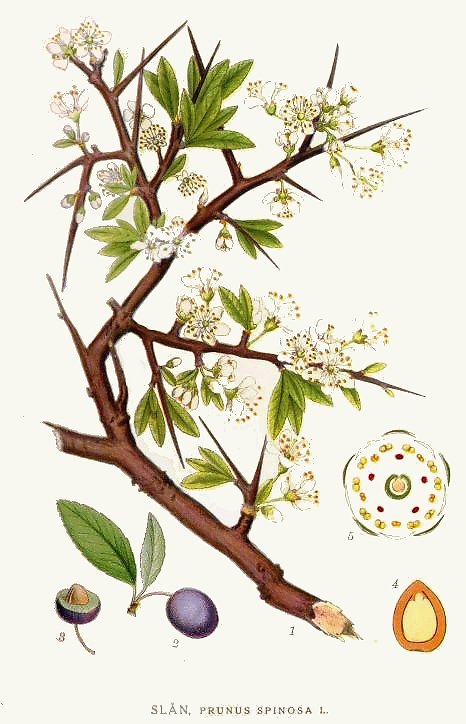
Name: Prunus spinosa L.
Family: Rosaceae
It was first described scientifically in 1753 by Swedish Carl Linnaeus in Species Plantarum
Common Names* in the British Isles and the Isle of Ireland
- English: Blackthorn (BLAK-thorn), sloe (sloh)
- Scots: slae (SLAY)
- Scots Gaelic: droighneag (DROO-nyak), sluach (SLOO-akh), àirne (AHR-nyeh)
- Irish Gaelic: Draighean (drain OR dray-un)
- Welsh: draenen ddu (DRAI-nen THEE)
- Manx: Drine arn (DRYN ARN)
- Cornish: spernen dhu (sper-nen do)
- Old English: slāh (SLAH)
Species Description
A spiny and densely branched shrub or small tree with small, narrow deciduous leaves. It typically reaches a height of about 6-7 metres (about 19-23 feet) and can live up to 100 years. The tree is characterised by its dark brown bark and thorns that protrude at right angles, which give it the common name “blackthorn.”

In spring, the blackthorn produces small bowl-shaped white flowers with five petals. These flowers appear just before the leaves and have a musky fragrance.
The tree also bears bluish-black fruit known as “sloes.” These fruits, have a white bloom or powdery coating on their surface. Like cherries and apricots, sloes are stone fruits. However, the flesh of sloes is bitter and inedible for humans.
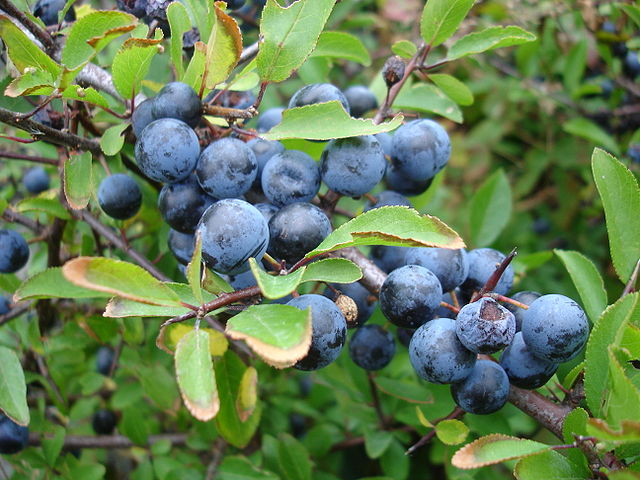
It thrives in a variety of habitats. It is commonly found in woodlands, hedgerows, scrublands, and open fields. Blackthorn is adaptable and can tolerate a range of soil conditions.
Royal Botanic Garden Edinburgh (RBGE) Herbarium Specimens
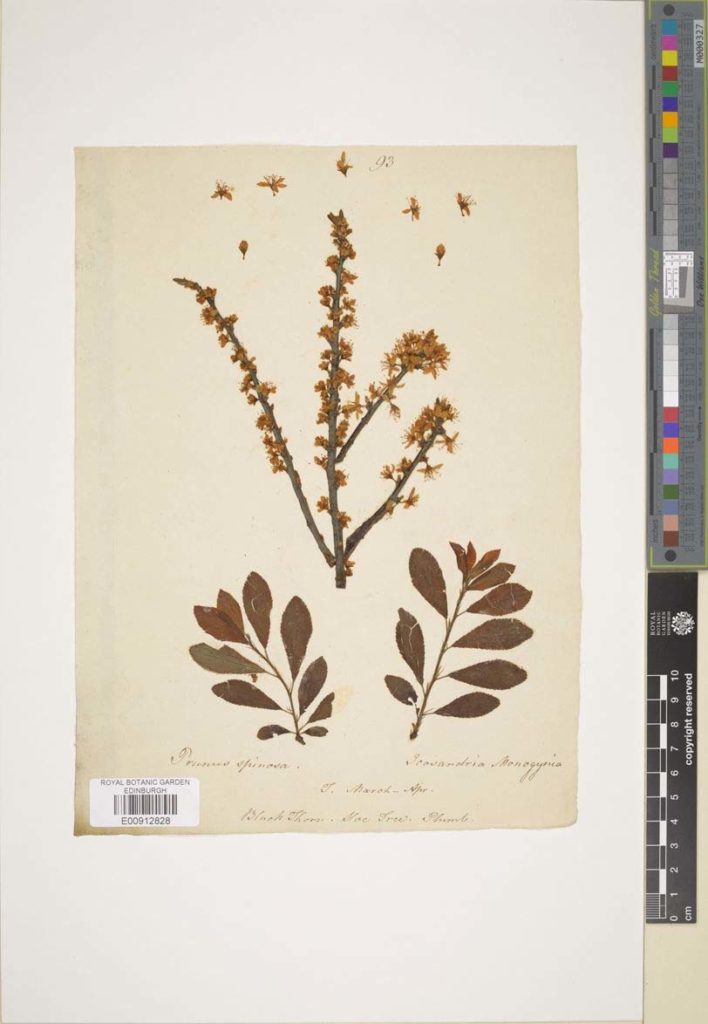
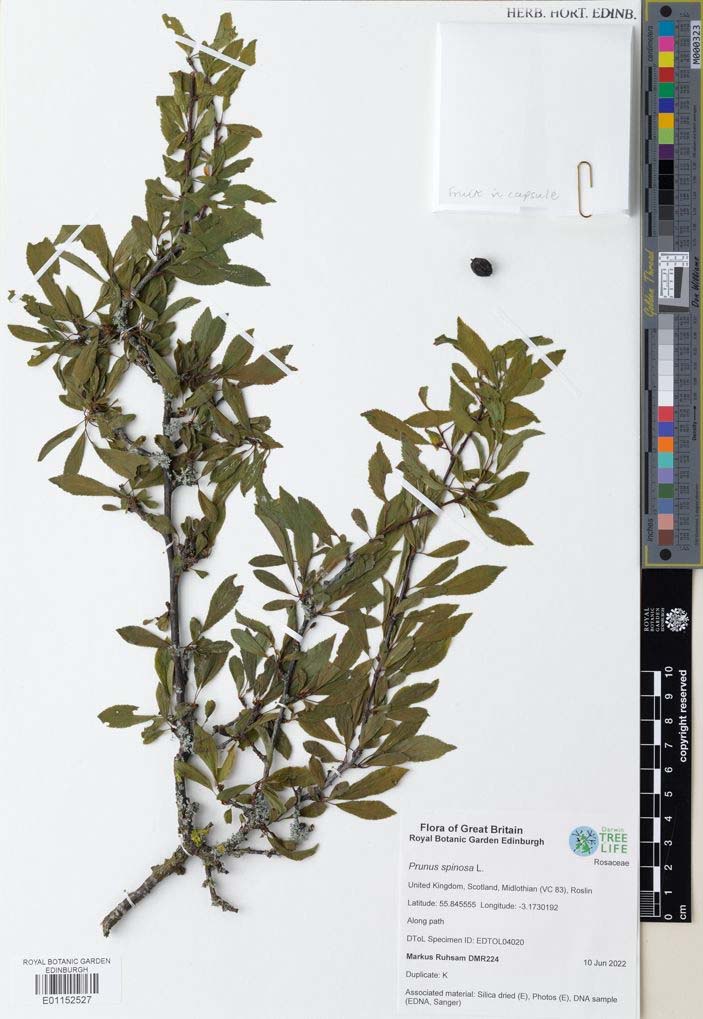
Total number of Specimens held in the British Collection within the Herbarium: 51 Specimens 1
The digitisation of this species within our collections from the British Isles is now complete. This allows us to see how our collections are distributed and compare this to the species range data recorded by the Botanical Society of Britain and Ireland.
Break down by Geographical Region
| Country | Specimen Count |
| Scotland | 36 |
| England | 15 |
| Wales | 0 |
| Channel Islands | 0 |
| Ireland (Republic of Ireland & Northern Ireland) | 0 |
Distribution
Prunus spinosa is found throughout the British Isles and Ireland, typically inhabiting the fringes of woodlands or old hedgerows. While native to Europe and western Asia, it has been extensively planted, making it challenging to distinguish its native and non-native range in certain regions. This is particularly true in Scotland, where it seems to have been introduced in some areas like the Isle of Skye.
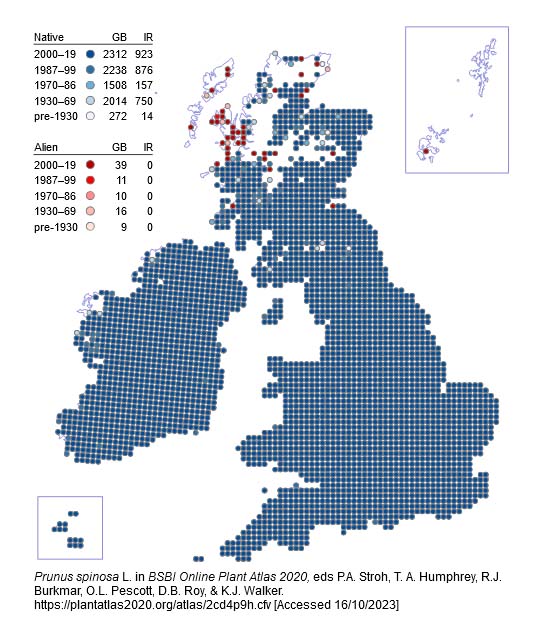
For a map of the worldwide distribution of Prunus spinosa L. visit Plants of the World Online.
Uses, Past & Present in the British Isles and the Isle of Ireland
- The fruit, known as sloe, is used for flavouring alcoholic beverages (e.g. sloe gin)
- Timber (e.g. in Ireland it is the traditional wood for making shillelaghs, a type of walking sitck)
- Hedgerow
- Sewing needles
- Metal-work
- Medicine
Sayings from the British Isles and the Isle of Ireland
Here are a few sayings from the British Isles and Ireland related to blackthorn and its folklore:
“Blackthorn Winter”
In rural England, it refers to a spell of cold weather that occurs in early spring or summer when blackthorn flowers are in bloom.
“Many sloes, many groans” or “Many sloes, many cold toes”
These sayings suggest that if there is a plentiful harvest of sloe berries (the fruit of the blackthorn), it indicates a hard winter ahead, which may lead to poverty and hardship.
These sayings reflect the connection between natural phenomena, such as the flowering and fruiting of blackthorn and other trees, and the anticipation of weather conditions, particularly during the winter season.
Literary References from the British Isles and the Isle of Ireland

The inclusion of Prunus spinosa, or blackthorn, in literature and folklore signifies its cultural importance and the profound interplay between nature and storytelling in the UK and Ireland. Here are a few instances of literary references to blackthorn in these regions:
“Tá mo ghrá-sa mar bhláth na n-airne ar an draighneán donn”
Seán Tóibín, Troscan na mBanta (1967)
[English Translation]
‘My love is like the flower on the dark blackthorn’. i.e. fair of skin with dark hair.
Seán Tóibín, Troscan na mBanta (1967)
[English translation]
“First came the Alder,
Câd Goddeu, Llyfr Taliesin (The Battle of the Trees, Book of Taliesin) (14th century poem)
Which struck the first blow.
Willow and Rowan
Came late to the muster.
The spiny Blackthorn
Was hungry for bloodshed.”
“The twa appear’d like sisters twin,
Robert Burns, The holy fair (1875)
In feature, form, an’ claes;
Their visage wither’d, lang an’ thin,
An’ sour as onie slaes”
[English translation]
“The two appeared like twin sisters,
Robert Burns, The Holy Fair (1785)
In feature, form, and clothes;
Their visage withered, long and thin,
And sour as any sloes”
“But the Entwives gave their minds to the lesser trees…and they saw the sloe in the thicket, and the wild apple and the cherry blossoming in the spring, and the green herbs in the waterlands in summer, and the seeding grasses in the autumn fields.”
JRR Tolkien, Lord of the Rings Two Towers Book 3, Chapter 4 (1954)
Prunus spinosa is a fascinating tree with a rich history of folklore and mythology in the British Isles and the Isle of Ireland. It is a reminder of the deep connection between humans and the natural world.
Footnotes
- Please note, that the Herbarium contains more specimens of Prunus spinosa from other parts of the world. These figures are not included. ↩︎
